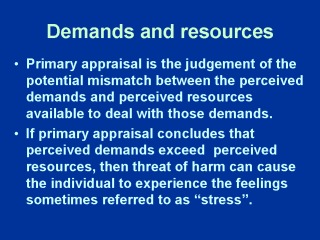| front |1 |2 |3 |4 |5 |6 |7 |8 |9 |10 |11 |12 |13 |review |
 |
Primary appraisal
estimates the perceived demands that the individual faces and the perceived
resources available to tackle those demands. Normally, if this comparison reveals
perceived resources adequately exceed perceived demands, then no sense of being “under
pressure” will be experienced. However, if the consequences of failing to successfully
manage the demands are significant (such as death) and the coping resources are seen as
only just adequate, then considerable stress, with the amount of stress increasing as the
extent of control over demands becomes more marginal). When perceived demands exceed perceived resources, then the symptoms also referred to as “stress” begin to appear. These include decrements in performance and function, subjective feelings of tension, fatigue, irritability, anxiety and depression, and sleep disruption. (Note how the word stress is used to refer to both the “cause” and also to the “effect” - it is a very imprecise term and made largely useless as a result of such misuse and misunderstanding). Thus, the process of primary appraisal is the estimation of the extent of potential harm. This initiates coping responses, activity to deal with or respond to the perceived demands. So, to summarize so far, when people perceived that the demands they face exceed the resources the perceive they have available to cope, they experience the disturbance called stress. Threat is the potential for harm which is anticipated to occur if coping responses are unsuccessful in avoiding, deflecting or minimizing the threatened harm. |